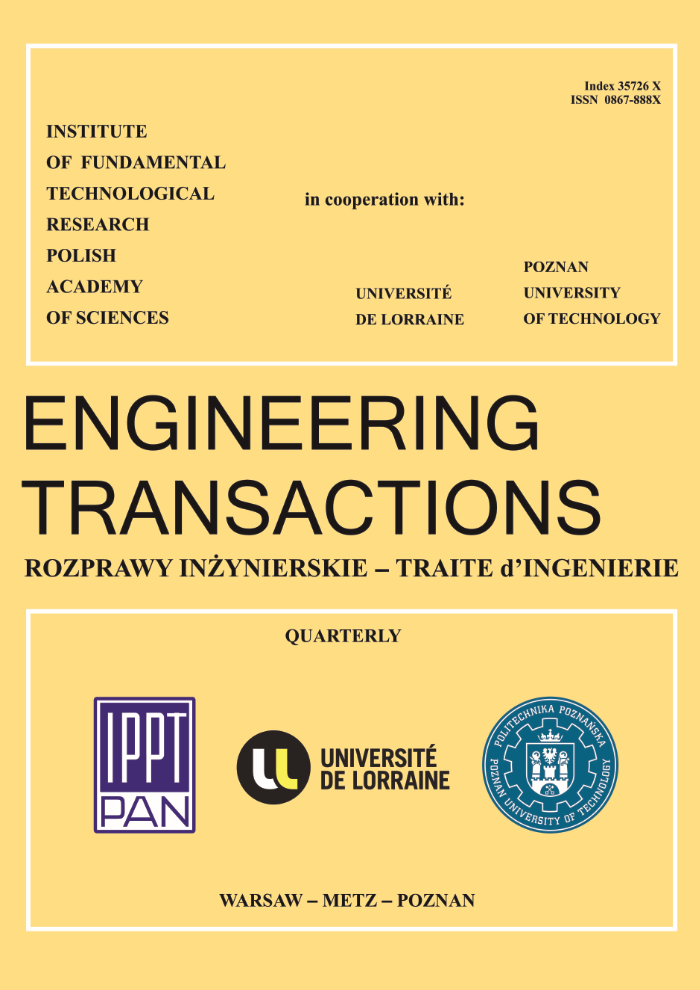Abstract
This paper presents new experimental data on AISI 1045 steel from the NIST pulse-heated Kolsky Bar Laboratory. The material is shown to exhibit a stiffer response to compressive loading when it has been rapidly preheated, than it does when it has been heated using a slower preheating method, to a testing temperature that is below the eutectoid temperature. It is argued, using a simple model for heat generation in the workpiece and the tool during machining, due to Tlusty, that this work has important implications for the modelling of high- speed machining operations. Based on the experimental data, a modification is recommended of the well-known Johnson-Cook constitutive model of Jaspers and Dautzenberg for this material, in order to achieve improved predictions of the peak cutting temperature in machining.Keywords:
high-speed machining, thermal modelling, AISI 1045 steel, Kolsky barReferences
1. ABAQUS/Explicit Users’ Manual, Hibbit, Karlsson & Sorenson, Inc., Rising Sun Mills, 166 Valley Street, Providence, RI 02909–2499, 2003.
2. Boothroyd G., Temperatures in orthogonal metal cutting, Proc. IME, 177, 29, 789–802, 1963.
3. Burns T.J., Mates S.P., Rhorer R.L., Whitenton E.P., Basak D., Dynamic properties for modeling and simulation of machining: effect of pearlite to austenite phase transition on flow stress in AISI 1075 steel, Mach. Sci. and Tech., 15, 1–20, 2011.
4. Buryta D., Sowerby R., Yellowley I., Stress distributions on the rake face during orthogonal machining, Int. J. Mach. Tools Manufact., 345, 721–739, 1994.
5. Childs T.H.C., Maekawa K., Obikawa T., Yamane Y., Metal Machining: Theory and Applications, Arnold Publishers, London, 2000.
6. Davies M.A., Yoon H., Schmitz T.L., Burns T.J., Kennedy M.D., Calibrated thermal microscopy of the tool-chip interface in machining, Mach. Sci. and Tech., 7, 2, 166–190,
2003.
7. Davies M.A., Cao Q., Cooke A.L., Ivester R., On the measurement and prediction of temperature fields in machining AISI 1045 steel, CIRP Ann., 52, 1, 77–80, 2003.
8. Jaspers S.P.F.C., Metal Cutting Mechanics and Material Behaviour, Ph.D. Thesis, Eindhoven: Technische Universiteit Eindhoven, 1999.
9. Jaspers S.P.F.C., Dautzenberg J.H., Material behaviour in conditions similar to metal cutting: flow stress in the primary shear zone, J. Mater Proc. Tech., 122, 322–330, 2002.
10. Johnson G.R., Cook W.H., A constitutive model and data for metals subjected to large strains, high strain rates and high temperatures, 7th International Symposium on Ballistics, 541–547; The Hague, Netherlands, 1983.
11. Kaluba W.J., Taillard R., Foct J., The bainitic mechanism of austenite formation during rapid heating, Acta Mater., 46, 16, 5917–5927, 1998.
12. Mates S.P., Rhorer R.L., Whitenton E.P., Burns T.J., Basak D., A pulse-heated Kolsky bar technique for measuring flow stress of metals subjected to high loading and heating rates, Exp. Mech., 48, 799–807, 2008.
13. Tlusty J., Manufacturing Processes and Equipment, Prentice-Hall, Upper Saddle River, NJ, 2000.
2. Boothroyd G., Temperatures in orthogonal metal cutting, Proc. IME, 177, 29, 789–802, 1963.
3. Burns T.J., Mates S.P., Rhorer R.L., Whitenton E.P., Basak D., Dynamic properties for modeling and simulation of machining: effect of pearlite to austenite phase transition on flow stress in AISI 1075 steel, Mach. Sci. and Tech., 15, 1–20, 2011.
4. Buryta D., Sowerby R., Yellowley I., Stress distributions on the rake face during orthogonal machining, Int. J. Mach. Tools Manufact., 345, 721–739, 1994.
5. Childs T.H.C., Maekawa K., Obikawa T., Yamane Y., Metal Machining: Theory and Applications, Arnold Publishers, London, 2000.
6. Davies M.A., Yoon H., Schmitz T.L., Burns T.J., Kennedy M.D., Calibrated thermal microscopy of the tool-chip interface in machining, Mach. Sci. and Tech., 7, 2, 166–190,
2003.
7. Davies M.A., Cao Q., Cooke A.L., Ivester R., On the measurement and prediction of temperature fields in machining AISI 1045 steel, CIRP Ann., 52, 1, 77–80, 2003.
8. Jaspers S.P.F.C., Metal Cutting Mechanics and Material Behaviour, Ph.D. Thesis, Eindhoven: Technische Universiteit Eindhoven, 1999.
9. Jaspers S.P.F.C., Dautzenberg J.H., Material behaviour in conditions similar to metal cutting: flow stress in the primary shear zone, J. Mater Proc. Tech., 122, 322–330, 2002.
10. Johnson G.R., Cook W.H., A constitutive model and data for metals subjected to large strains, high strain rates and high temperatures, 7th International Symposium on Ballistics, 541–547; The Hague, Netherlands, 1983.
11. Kaluba W.J., Taillard R., Foct J., The bainitic mechanism of austenite formation during rapid heating, Acta Mater., 46, 16, 5917–5927, 1998.
12. Mates S.P., Rhorer R.L., Whitenton E.P., Burns T.J., Basak D., A pulse-heated Kolsky bar technique for measuring flow stress of metals subjected to high loading and heating rates, Exp. Mech., 48, 799–807, 2008.
13. Tlusty J., Manufacturing Processes and Equipment, Prentice-Hall, Upper Saddle River, NJ, 2000.






